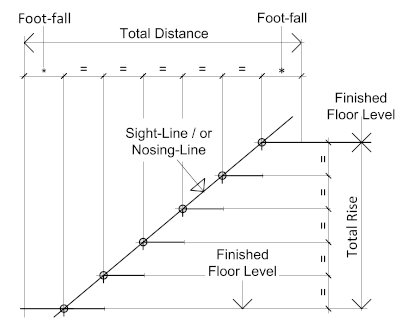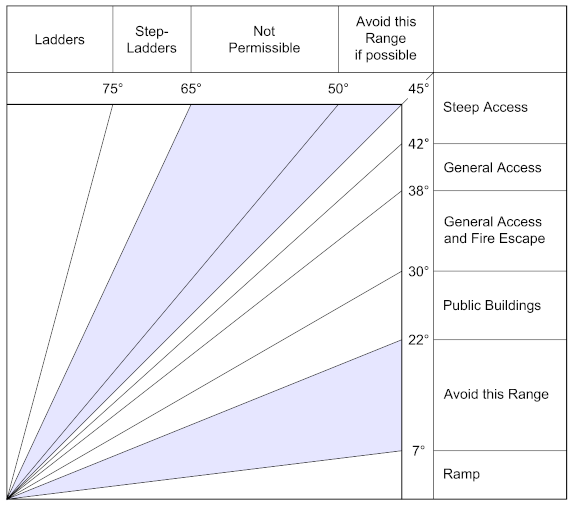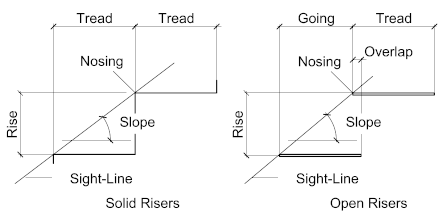A badly designed stairway is an accident waiting to happen; too often designers do not pay sufficient attention to the geometry that can make a stair access comfortable and safe or perilous and downright dangerous. The geometry of public access stairways and fire escapes are usually determined by regional codes and regulations, but even then, many are not as they should be. Space constraints (and stairways can take up a lot of that) often dictate the geometry, where the space is allocated, and the stairway must fit into it.
Proper stair design is not rocket science, and codes and regulations aside, there are a few rules that must be observed which are more common sense than regulatory:

- The stair slope is determined by its designed application, i.e. Public access, fire escape, general access, or steep access for industrial / maintenance environments
- The stair slope will determine the rise and tread depth
- The stair risers and tread depth must be consistent for the entire flight, permissible variations are given in regional codes, but that aside, keep them as near as possible the same
- Maintain a consistent ‘sight-line’ for the entire flight, that is to say, all the stair nosing’s should be visible when looking down from the top
- Public access stairways and fire escapes must accommodate a wide section of the general population including, the elderly, infirm, children, women in high-heel shoes, and all those not in tip-top condition. Consequently, stairways should have solid treads, closed or solid risers, and non-slip nosing’s.
- In certain circumstances where the stairway is located outside and exposed to the elements open risers may be permissible
- There must be a clear and visible foot-fall at the top and bottom of each flight, that is to say the landing must be clearly defined and visible
- The total rise for each stair flight should not exceed 3m.
- The total Rise is always measured from the top and bottom finished floor levels. The finished floor level may be either steel or concrete, with a concrete floor it must be measured from the finished screed. If the stair is mounted on a concrete plinth, then the height of the plinth should be equal to the first stair riser with a non-slip nosing cast into the leading edge.
- Stairways should never decrease in width in the direction of travel
It must be emphasized that apart from the common-sense guidelines local codes and regulations must be observed, particularly with regards to public access areas and fire escapes.
Public access areas cover a wide spectrum of applications ranging from business and commercial buildings, residential complexes, shopping malls, museums and galleries, to large multi-purpose stadiums. Each will have their own guidelines and applicable regulations. It is the engineer’s or architect’s responsibility to ensure those regulations are adhered to.
The following diagram is a guideline to optional stair slopes and their respective applications:
Ladders and step-ladders will be covered in their own section. Likewise, handrails and balustrading will be covered under a separate heading.
Stair Slopes

Ramps are smooth slopes at an angle of between 3° and 7°, which may extend to 10 degrees in exceptional circumstances.
The ramp geometry is again determined by its application, and here many statutory requirements apply, particularly with regard to wheelchairs and general access for the disabled. Not only is the ramp geometry covered by these regulations but also its properties with regard to grip in conditions which could make them slippery.
Ramps are a subject unto themselves and generally do not fall within the scope of this article.
Stair Risers and Treads - Terminology
Slope
Slope is the angle of the stairway measured from the horizontal plane.
- Ideally, for use by the general public, the slope should be between 22 and 30 degrees depending on the specific application.
- For general access, the slope should be between 30 and 38 degrees.
- 38 degrees is generally the maximum slope allowing solid risers
- Between 39 and 42 degrees should be limited to industrial applications for infrequent access and maintenance
- Between 43 and 45 degrees is considered a steep access, and likewise should be limited to industrial applications
- Between 46 and 50 degrees is considered undesirable and should be avoided, if for whatever reason it cannot be avoided, their use should be restricted.

Rise
Rise is the vertical distance between steps, ideally it should be between 175 and 195 mm depending on the slope of the stairway. The shallower the slope, the less the rise.
Generally, the rise should never exceed 200 mm.
Tread
Tread is the horizontal depth of the stair tread, ideally it should not be less than 250 mm for closed risers
Going
Going: is the horizontal distance between the stair-tread nosing’s. The term applies to stairways with open risers (stairs with a slope of greater than 38 degrees)
Overlap
Overlap is the horizontal overlap distance between the stair-treads, it is calculated by (Tread - Going) which should be between 25 and 30 mm
Nosing
Nosing refers to the non-slip sighting edge of the stair tread, non-slip nosing’s are mandatory for stairways with open-grid type stair treads, any sharp corners must be ground to provide a radius of not more than 5 mm
Site-Line
Sight-Line or Nosing-Line refers to the line-of-sight of the stair nosing’s when viewed down from the top. They should all be visible on a properly aligned stairway
Stair Width
The width of the stairway is measured as the clear distance between the stringers and is often determined by the standard stair treads offered by the manufacturers, which may vary, so check with local suppliers.
| Stair Width | Application |
| 600 | Generally, this would be regarded as the minimum practical stair width and limited to an industrial environment. It allows only a single direction movement and would typically be employed to provide infrequent access for inspection and maintenance purposes |
| 750 | This would represent a general access stairway, again as would typically found in an industrial environment, it is generally regarded as a single direction stairway, but will allow people to pass |
| 1000 | This is regarded as the minimum width for regular 2-way traffic |
| 1100 | This is regarded as the minimum width for emergency escape routes |
Headroom
The clear headroom should ideally not be less than 2100 when measured from the lowest obstruction. In certain applications where this is not achievable (infrequent maintenance access etc.) then warning signs should be in place and the obstruction should be painted in accordance with local regulations.
Again, it must be mentioned that stair widths, especially those forming escape routes are determined by regional statutes, for example the regulations that apply to a 2-storey apartment building will differ from those that would apply to a football stadium, so refer to these regulations and take guidance from the engineer or architect.
